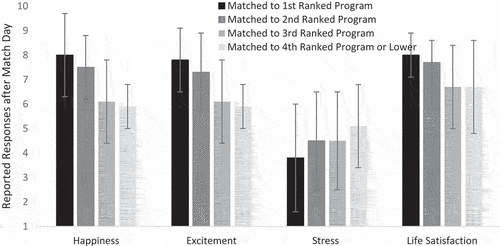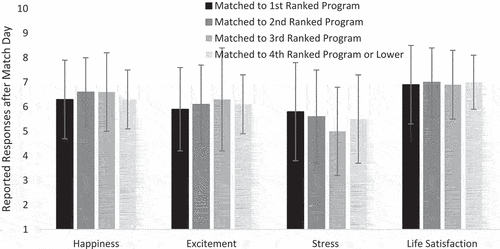Figures & data
Table 1. Medical residency applicants were asked to report the five factors that were most important to them in making decisions about their Rank Order List. These open-ended responses were categorized into eight categories. The numbers represent the percentage of participants who listed each decision factor as being 1st, 2nd, 3rd, 4th, or 5th most important in their decision-making process.
Table 2. Participants rated the importance of each of 24 factors in their decisions for Rank Order Lists on a 9-point scale from not important (1) to extremely important (9). Factors were combined in some cases into superordinate categories, presented in bold below. The numbers represent the mean (M) rated importance of each factor, accompanied by the associated Standard Deviation (SD).
Figure 1. Participants rated the intensity of their responses of happiness, excitement, stress, and life satisfaction shortly after learning the outcome of Match Day on a 9-point scale from not at all (1) to most extreme possible (9). These responses are broken out in the figure according to whether they matched with their 1st choice, their 2nd choice, their 3rd choice, or their 4th or lower choice. Values represent the mean rated intensity of each response after Match Day, accompanied by the associated Standard Deviation.

Figure 2. Participants rated the intensity of their responses of happiness, excitement, stress, and life satisfaction after beginning their residency program on a 9-point scale from not at all (1) to most extreme possible (9). These responses are broken out in the figure according to whether they matched with their 1st choice, their 2nd choice, their 3rd choice, or their 4th or lower choice. Values represent the mean rated intensity of each response, accompanied by the associated Standard Deviation.

Table 3. Participants rated the perceived alignment between themselves and the program on 9-point scales from does not meet my needs at all (1) to perfectly suited to my needs (9), as well as their responses shortly after Match Day on 9-point scales from not at all (1) to most extreme possible (9). The table presents the results from linear regression analyses with rated congruency on each factor predicting responses of happiness, excitement, stress, and life satisfaction shortly after Match Day. β represents the standardized beta value.
Table 4. Participants rated the perceived alignment between themselves and the program on 9-point scales from does not meet my needs at all (1) to perfectly suited to my needs (9), as well as their responses after beginning their residency program on 9 point scales from not at all (1) to most extreme possible (9). The table presents the results from linear regression analyses with rated congruency on each factor predicting responses of happiness, excitement, stress, and life satisfaction after starting their residency program. β represents the standardized beta value.
